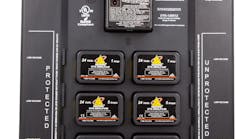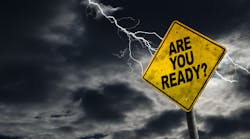Tips for protecting your fire alarm systems from power surges
The importance of fire alarm systems cannot be overstated. From saving lives to protecting valuable property and equipment, fire alarm systems are a mainstay of all modern buildings. So much so that their use in residences, businesses, and public buildings is mandated under a number of National Fire Protection Association (NFPA) codes. NFPA codes ensure applicable fire and life safety systems are functioning properly and consistently. If a system is found to be in violation of fire codes due to downtime or other mismanagement, the deploying organization could be subject to costly fines and/or facility shutdowns.
One of the most problematic and overlooked challenges associated with maintaining consistent operations of fire alarm systems is system failure caused by power surges and spikes. Disruptive power events can severely damage or destroy fire alarm systems without notice, providing a false sense of security as individuals believe their alarm systems are working when in fact, they are not.
In one scenario, a surge-damaged system would be identified during a routine fire safety inspection and the offending organization subject to applicable fines for fire code violations. In a worst-case scenario, a failed system would go unnoticed until a fire is well underway, resulting in devastating losses. The implementation of surge protection devices (SPDs) is one of the only ways to prevent both undesirable scenarios.Power Surges Strike When Least Expected
One common misconception is that power surges are only caused by lightning and therefore electrical equipment is only at-risk during thunderstorms. In reality, lightning strikes account for only 2% of all surge-related damage according to the Insurance Institute for Business and Home Safety. Power surges originate from a variety of sources, happening either all at once (as is the case with lightning strikes) or over time, causing them to go largely unnoticed.
Overlooked sources of sudden power surges include external sources such as utility grid switching or large neighboring power draws, and even internal sources generated from inside the building itself. Powering up internal HVAC systems, elevators, refrigeration systems, and other high-powered motors and pumps generates sudden bursts of power, which all have a cumulative effect on electronic equipment. Sensitive Fire Alarm Control Panels (FACPs) are no different. As an FACP experiences small transient surges, the panel and connected systems deteriorate slowly over time. While the effects are often unnoticeable to the human eye, they do lead to shorter equipment lifecycles and unexpected failures.
Another common misconception is that FACPs with built-in circuit protection does not require external surge protection. The truth is that surge protection built into any individual device will not protect all of the various system components from damaging power disruptions.
An Expanding Attack Surface
Fire safety technology has only evolved in recent years to address the growing patchwork of local and state fire codes as well as new safety concerns. The introduction of the Internet of Things (IoT) to fire protection systems only serves to increase the proactive aspects of monitoring and alert notification. For example, new IoT solutions have the capability to alert building owners of faulty heads or pipes in the sprinkler system. Smart sensors can also monitor water pressure and flow rate in the building’s sprinkler system, so the water output automatically adjusts to meet the intensity of a building fire, potentially saving lives.
The unfortunate downside of this interconnection is the increased risk of power surge damage for every new IoT that is added. New smart sensors, video image smoke detection technology, voice evacuation systems, and other IoT accessories are each made up of unique electronic components and, as such, subject to the same power surges and spikes as any other electronic device. Since power surges can spread through connected systems, a connected IoT device experiencing a power surge can potentially take down a whole fire alarm system, network, and more. When one critical system is unprotected from surges, others are vulnerable.
Applying the Proper Protection
To shield valuable fire alarm systems from damaging surge events, surge protective devices should be installed on every potential pathway. As the “brain” of the fire alarm system, the central control panel requires a surge protective device for its 120V power source. The FACP connects all system sensor and device inputs via Signaling Line Circuits (SLC), which allows the FACP to monitor and control all connected detectors and input/output modules, controlling alarms and outputs to other systems, and information relays. As such, the FACP necessitates surge protection, but it’s important to note that FACP surge protection is not sufficient for system-wide protection.
Because FACPs connect to external power and devices, all connected devices are susceptible to electrical disturbances – including accidental contact with power lines, or induced currents from nearby lightning strikes. Any external wiring, such as SLC wiring that connects multiple buildings or notification systems that employ the use of telephone lines and other IP peripherals to summon an emergency response, is also at risk for power disruptions. So much so that NFPA code 72 – 2013, Chapter 12 mandates that, “all non-power-limited and power-limited signaling system circuits entering a building shall be provided with transient protection.” In these instances, surge protectors help prevent surges applied to exterior wiring and devices from damaging interior fire alarm systems.
The True Cost of Power Loss
Just as the importance of fire alarms cannot be overstated, neither can the importance of surge protection. In the absence of surge protection, the cost to repair or replace a damaged fire alarm system could be well into the millions of dollars. If other networks or devices were damaged as a result, costs could easily multiply to an unmanageable amount. Making matters worse, organizations may be mandated by local fire codes to pay a local department for a “fire watch,” a manual observation for fire hazards, while the alarm system is being replaced. This does not account for any fire code violation fines that may be issued for a damaged system uncovered during routine fire safety inspections.
Beyond monetary losses, there are incalculable losses that can occur as a result of a failed fire alarm system. If a fire were to occur during system downtime, property and equipment damage could require a forceable closure of a business from which recovery may not be possible. A similar loss of employee and customer trust could lead to irreparable brand damage. Personal injury and loss of life are other very real possibilities when it comes to an inoperable fire alarm system, only highlighting the immediate need for fire alarm surge protection.
Today’s Surge Protection Solutions
The application of surge protection devices throughout a fire alarm system is a cost-effective way to manage risk in professional applications. For a fraction of the cost of complete system replacement and potentially less than fire code violation fines, organizations can protect their assets from a potentially devastating physical security threat. In recent years, SPDs have increased in functionality, efficiency, and cost-effectiveness with the integration of modern technologies.
For example, because of SPDs’ self-sacrificing nature, regular device inspections were previously required to ensure that all devices were functioning properly. This process was traditionally labor intensive and costly but missing an inspection could negate the function of an SPD in the first place. Now, innovative SPDs are equipped with LED and audible status indicators that alert a user to a device that reached its end of life. More advanced units also include dry contacts to facilitate remote notification of surge protection status.
Surge protection delivers peace of mind for organizations just as fire alarm systems do the same for their employees and guests. It is important that security teams, electricians, and technicians see surge protection as mission-critical equipment in a fire alarm system rather than as an option. Doing so not only saves money, but it also has the potential to save lives.






